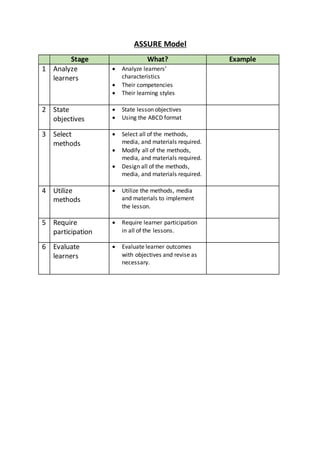Designing Teaching: ASSURE
•Als DOCX, PDF herunterladen•
0 gefällt mir•129 views
Designing Teaching: ASSURE Check out: Heinich, R., Molenda, M., & Russell, J. D., (1993). Instructional Media and The New Technologies of Instruction. New York: Macmillan
Melden
Teilen
Melden
Teilen

Empfohlen
Empfohlen
Weitere ähnliche Inhalte
Was ist angesagt?
Was ist angesagt? (20)
Designing and conducting formative evaluations chapter 10

Designing and conducting formative evaluations chapter 10
Ähnlich wie Designing Teaching: ASSURE
Ähnlich wie Designing Teaching: ASSURE (20)
Mehr von Damian T. Gordon
Mehr von Damian T. Gordon (20)
Universal Design for Learning, Co-Designing with Students.

Universal Design for Learning, Co-Designing with Students.
Designing Teaching: Gagne's Nine Events of Instruction

Designing Teaching: Gagne's Nine Events of Instruction
Universally Designed Learning Spaces: Some Considerations

Universally Designed Learning Spaces: Some Considerations
Kürzlich hochgeladen
God is a creative God Gen 1:1. All that He created was “good”, could also be translated “beautiful”. God created man in His own image Gen 1:27. Maths helps us discover the beauty that God has created in His world and, in turn, create beautiful designs to serve and enrich the lives of others.
Explore beautiful and ugly buildings. Mathematics helps us create beautiful d...

Explore beautiful and ugly buildings. Mathematics helps us create beautiful d...christianmathematics
Mehran University Newsletter is a Quarterly Publication from Public Relations OfficeMehran University Newsletter Vol-X, Issue-I, 2024

Mehran University Newsletter Vol-X, Issue-I, 2024Mehran University of Engineering & Technology, Jamshoro
Kürzlich hochgeladen (20)
ICT role in 21st century education and it's challenges.

ICT role in 21st century education and it's challenges.
Unit-IV; Professional Sales Representative (PSR).pptx

Unit-IV; Professional Sales Representative (PSR).pptx
Mixin Classes in Odoo 17 How to Extend Models Using Mixin Classes

Mixin Classes in Odoo 17 How to Extend Models Using Mixin Classes
Basic Civil Engineering first year Notes- Chapter 4 Building.pptx

Basic Civil Engineering first year Notes- Chapter 4 Building.pptx
Explore beautiful and ugly buildings. Mathematics helps us create beautiful d...

Explore beautiful and ugly buildings. Mathematics helps us create beautiful d...
Food Chain and Food Web (Ecosystem) EVS, B. Pharmacy 1st Year, Sem-II

Food Chain and Food Web (Ecosystem) EVS, B. Pharmacy 1st Year, Sem-II
Role Of Transgenic Animal In Target Validation-1.pptx

Role Of Transgenic Animal In Target Validation-1.pptx
Presentation by Andreas Schleicher Tackling the School Absenteeism Crisis 30 ...

Presentation by Andreas Schleicher Tackling the School Absenteeism Crisis 30 ...
Ecological Succession. ( ECOSYSTEM, B. Pharmacy, 1st Year, Sem-II, Environmen...

Ecological Succession. ( ECOSYSTEM, B. Pharmacy, 1st Year, Sem-II, Environmen...
Seal of Good Local Governance (SGLG) 2024Final.pptx

Seal of Good Local Governance (SGLG) 2024Final.pptx
General Principles of Intellectual Property: Concepts of Intellectual Proper...

General Principles of Intellectual Property: Concepts of Intellectual Proper...
Z Score,T Score, Percential Rank and Box Plot Graph

Z Score,T Score, Percential Rank and Box Plot Graph
Designing Teaching: ASSURE
- 1. ASSURE Model Stage What? Example 1 Analyze learners Analyze learners’ characteristics Their competencies Their learning styles 2 State objectives State lesson objectives Using the ABCD format 3 Select methods Select all of the methods, media, and materials required. Modify all of the methods, media, and materials required. Design all of the methods, media, and materials required. 4 Utilize methods Utilize the methods, media and materials to implement the lesson. 5 Require participation Require learner participation in all of the lessons. 6 Evaluate learners Evaluate learner outcomes with objectives and revise as necessary.
- 2. The ABCD Format Steps Description A Audience The audience is the group of individuals who are targeted for instruction. While at first this seems straight forward, many times employees will ask “will I get anything out of this training?” or “should I attend this training?” or “who is supposed to go to this training?” Without a clear-cut audience in mind, it is difficult to pinpoint exactly who gains from the training and who would be better served in a different class. B Behaviour The behaviour element of the objective indicates the desired outcome of the particular learning event. The behaviour will be stated in the following form “will be able to detail properly” or “will be able to discuss the mechanism of action with the doctor.” The behaviour is what you want the person to be able to do as a result of the training. It is important to clarify the behaviour because training programs can get off track when the desired outcome of the activity is not clearly defined. C Condition The term “condition” describes circumstances under which the behaviour should occur. An example would be “when calling on a doctor,” the condition describes a trigger for the desired behaviour. D Degree The term “degree” represents how well the student must perform to be considered acceptable. The degree of the objective is the measurable component. Measures can be expressed as level of productivity, quantity, quality, time, internal or external examiner requirements, or other criteria gained from actual or anticipated work practices.
